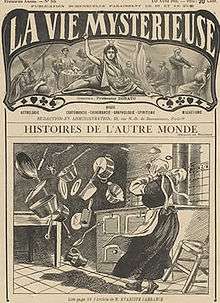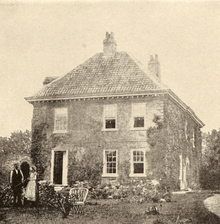Poltergeist

In folklore and parapsychology, a Poltergeist (German for "noisy ghost") is a type of ghost or other supernatural entity which is responsible for physical disturbances, such as loud noises and objects being moved or destroyed. They are purportedly capable of pinching, biting, hitting, and tripping people. Most accounts of poltergeists describe the movement or levitation of objects such as furniture and cutlery, or noises such as knocking on doors.
They have traditionally been described as troublesome spirits who haunt a particular person instead of a specific location. Such alleged poltergeist manifestations have been reported in many cultures and countries including the United States, India‚ Japan, Brazil, Australia, and most European nations. Early accounts date back to the 1st century.
Etymology
The word poltergeist came from the German language words poltern ("to make sound" and "to rumble") and Geist ("ghost" and "spirit"), and the term itself translates as "noisy ghost", "rumble-ghost" or a "loud spirit".
Suggested explanations
Natural phenomena
Many claimed poltergeist events have proved on investigation to be pranks.[1] Skeptic Joe Nickell says that claimed poltergeist incidents typically originate from "an individual who is motivated to cause mischief".[2] According to Nickell:
"In the typical poltergeist outbreak, small objects are hurled through the air by unseen forces, furniture is overturned, or other disturbances occur -- usually just what could be accomplished by a juvenile trickster determined to plague credulous adults."
Nickell writes that reports are often exaggerated by credulous witnesses.[3]
"Time and again in other “poltergeist” outbreaks, witnesses have reported an object leaping from its resting place supposedly on its own, when it is likely that the perpetrator had secretly obtained the object sometime earlier and waited for an opportunity to fling it, even from outside the room—thus supposedly proving he or she was innocent."
According to research in anomalistic psychology, claims of poltergeist activity can be explained by psychological factors such as illusion, memory lapses, and wishful thinking.[4] A study (Lange and Houran, 1998) wrote that poltergeist experiences are delusions "resulting from the affective and cognitive dynamics of percipients' interpretation of ambiguous stimuli".[5]
Attempts have also been made to scientifically explain poltergeist disturbances that have not been traced to fraud or psychological factors. Skeptic and magician Milbourne Christopher found that some cases of poltergeist activity can be attributed to unusual air currents, such as a 1957 case on Cape Cod where downdrafts from an uncovered chimney became strong enough to blow a mirror off of a wall, overturn chairs and knock things off shelves.[6]
Unverified natural phenomena
In the 1950s, Guy William Lambert proposed that reported poltergeist phenomena could be explained by the movement of underground water causing stress on houses.[7] He suggested that water turbulence could cause strange sounds or structural movement of the property, possibly causing the house to vibrate and move objects. Later researchers, such as Alan Gauld and Tony Cornell, tested Lambert's hypothesis by placing specific objects in different rooms and subjecting the house to strong mechanical vibrations.[7] They discovered that although the structure of the building had been damaged, only a few of the objects moved a very short distance. The skeptic Trevor H. Hall criticized the hypothesis claiming if it was true "the building would almost certainly fall into ruins."[8] According to Richard Wiseman the hypothesis has not held up to scrutiny.[7]
Michael Persinger has theorized that seismic activity could cause poltergeist phenomena.[9] However, Persinger's claims regarding the effects of environmental geomagnetic activity on paranormal experiences have not been independently replicated and, like his findings regarding the God helmet, may simply be explained by the suggestibility of participants.[10][11]
David Turner, a retired physical chemist, suggested that ball lightning might cause the "spooky movement of objects blamed on poltergeists."[12]
Paranormal
Parapsychologists such as Nandor Fodor and William G. Roll wrote that poltergeist activity can be explained by psychokinesis.[13][14]
Poltergeist activity has often been believed to be the work of malicious spirits. According to Allan Kardec, the founder of Spiritism, poltergeists are manifestations of disembodied spirits of low level, belonging to the sixth class of the third order. Under this explanation, they are believed to be closely associated with the elements (fire, air, water, earth).[15]
Famous cases
- Drummer of Tedworth (1662)
- Islandmagee witch trial (1710-1711)
- Epworth Rectory (1716–1717)
- Sampford Peverell (1810-1811)
- Bell Witch of Tennessee (1817–1872)
- Angelique Cottin (ca. 1846)
- Great Amherst Mystery (1878–1879)
- Caledonia Mills (1899-1922)
- Gef the Talking Mongoose (1931)
- Borley Rectory (1937) investigated by Harry Price who called it "the most haunted house in England".[16]
- Thornton Heath poltergeist (1938)
- Robbie Mannheim (1949), claimed to be demonically possessed after using a Ouija board.
- Seaford poltergeist (1958)
- Matthew Manning (1960s–1970s)[17]
- The Black Monk of Pontefract (1960s–1970s)
- Rosenheim Poltergeist (1967) investigated by Hans Bender who claimed that a law firm located in Rosenheim in southern Germany experienced disruption of electricity and telephone lines, swinging lamps, and the rotation of a framed picture caused by a 19-year-old secretary who he alleged called "a typical poltergeist."[18][19]
- The Enfield Poltergeist (1977)
- The Thornton Road poltergeist of Birmingham (1981)
- Tina Resch (1984)
- The Canneto di Caronia fires poltergeist (2004–5)[20]
- "The Stone-Throwing Spook of Little Dixie" (1995)[21]
In fiction
- Lithobolia, a narrative folk tale by "Richard Chamberlayne" first printed in London 1698 has been compared to modern poltergeist stories and considered an early example of esoteric literature and supernatural horror writing.
- In the 1941 Noël Coward play Blithe Spirit poltergeist activity is due to the ghost of the central character's first wife—and later to the ghosts of both wives. A successful movie in 1945, and a musical (High Spirits) in 1963, besides enjoying multiple adaptations to radio.
- An episode of Lost Tapes featured Charles' ghost who is haunting the house as a poltergeist in Lakeview, Colorado.
- William Peter Blatty's 1971 novel The Exorcist and its 1973 film adaptation depict demonic possession.
- In the Poltergeist movies (1982, 1986, 1988) poltergeist activity in a family home was caused by the ghosts attracted to the youngest daughter.
- A poltergeist named Peeves appears in the Harry Potter series, who is described by the series author J.K. Rowling as not a ghost but an "indestructible spirit of chaos."[22]
- The 2015 film Poltergeist, a remake of the 1982 film.
- The anime, Ghost Hunt focused on possible poltergeist activity in an old schoolhouse.
- In the 2D shooting series, Touhou Project there are three characters who are poltergeists, named Merlin Prismriver, Lunasa Prismriver and Lyrica Prismriver. Three of them are featured in the game Perfect Cherry Blossom (2003 game of the Touhou Project series).
See also
References
- ↑ Terence Hines. (2003). Pseudoscience and the Paranormal. Prometheus Books. p. 98. ISBN 978-1573929790
- ↑ Joe Nickell (3 July 2012). The Science of Ghosts: Searching for Spirits of the Dead. Prometheus Books. pp. 283–. ISBN 978-1-61614-586-6.
- ↑ Nickell, Joe. "Enfield Poltergeist, Investigative Files". August 2012. Committee for Skeptical Inquiry. Retrieved 3 December 2013.
- ↑ Leonard Zusne, Warren H. Jones. (1989). Anomalistic Psychology: A Study of Magical Thinking. Psychology Press. p. 192. ISBN 978-0805805086
- ↑ Lange, R., Houran, J. (1998). Delusions of the paranormal: A haunting question of perception. Journal of Nervous and Mental Disease, 186 (10), 637–645.
- ↑ Christopher, Milbourne (1970). ESP, Seers & Psychics: What the Occult Really Is. New York: Crowell. p. 142. ISBN 978-0-690-26815-7. OCLC 97063.
A heavy mirror fell from the bedroom wall and an ash tray that had been resting on a table with a glass top slammed against the surface with such force that the glass was shattered.
- 1 2 3 Wiseman, Richard. (2011). Paranormality: Why We See What Isn't There. Macmillan. pp. 167-169. ISBN 978-0-230-75298-6
- Lambert, G. W. (1955). Poltergeists: A Physical Theory. Journal of the Society for Psychical Research 38: 49-71.
- ↑ Dingwall, Eric; Hall, Trevor H. (1958). Four Modern Ghosts. Gerald Duckworth. p. 105
- ↑ Houran, James (2004). From Shaman to Scientist: Essays on Humanity's Search for Spirits. Lanham: Scarecrow Press. p. 11. ISBN 0-8108-5054-0.
- ↑ French, CC., Haque, U., Bunton-Stasyshyn, R., Davis, R. (2009), "The "Haunt" project: An attempt to build a "haunted" room by manipulating complex electromagnetic fields and infrasound", Cortex, 45 (5): 619–629, doi:10.1016/j.cortex.2007.10.011, PMID 18635163
- ↑ Wiseman, Richard. (2011). "The Haunted Brain". Csicop.org. Retrieved 2014-10-11.
- ↑ Muir, Hazel (2001-12-20). "Ball lightning scientists remain in the dark". New Scientist. Retrieved 2011-01-15.
- ↑ Fodor, N. (1964). Between Two Worlds. West Nyack, NY: Parker Publishing.
- ↑ James Houran, Rense Lange. (2007). Hauntings and Poltergeists: Multidisciplinary Perspectives. McFarland. p. 290. ISBN 978-0786432493
- ↑ Allan Kardec, Le Livre des Esprits. (2000). chapter 106, Jean de Bonnot. p.46.
- ↑ Harry Price, The Most Haunted House in England: Ten Years' Investigation (new edition, 1990)
- ↑ Nickell, Joe. (2015). "Poltergeist Scribbler: The Bizarre Case of Matthew Manning". Skeptical Inquirer. Retrieved 30 April 2016.
- ↑ Spraggett, Allen (Jan 2, 1974). "Pursuing the Elusive Poltergeist". The Pittsburgh Press. Retrieved 4 December 2013.
- ↑ Fairley, John; Welfare, Simon (1984). Arthur C. Clarke's World of Strange Powers. London: Harper Collins. pp. 28–31. ISBN 0-00-216679-8.
- ↑ "WorldWide Religious News-Devil in the detail of Sicily's mysterious village fires". Wwrn.org. 2004-02-11. Retrieved 2009-08-19.
- ↑ "The Stone-Throwing Spook of Little Dixie"
- ↑ "The Leaky Cauldron and MuggleNet interview Joanne Kathleen Rowling: Part Two". 2005. Retrieved 2007-06-01.
Further reading
- Christopher, Milbourne (1970). ESP, Seers & Psychics. Thomas Y. Crowell Co. ISBN 978-0-690-26815-7
- Nickell, Joe (2012). The Science of Ghosts: Searching for Spirits of the Dead. Prometheus Books. ISBN 978-1-61614-586-6
- Podmore, Frank (1896). Poltergeists. Proceedings of the Society for Psychical Research 12: 45-115.
- Price, Harry (1993). Poltergeist: Tales of the Supernatural. London: Bracken Books. ISBN 1-85891-084-6.
- Sitwell, Sacheverell. (1988). Poltergeists: An Introduction and Examination Followed by Chosen Instances. Dorset Press.
External links
| Look up poltergeist in Wiktionary, the free dictionary. |
- "Poltergeist" caught on video, The Sun UK newspaper, August 9, 2008.
- The Poltergeist and his explainers, Andrew Lang, Psychanalyse-paris.com
- Skeptic's Dictionary
- Poltergeists in WA
- UK Parapsychology Team declare home Haunted
- The Columbus Poltergeist
